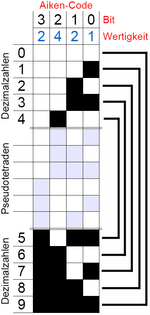Aiken code
| Aiken code | |
|---|---|
| Digits | 4[1][2] |
| Tracks | 4[1][2] |
| Digit values | 2 4 2 1[1][2] |
| Weight(s) | 0..4[1][2] |
| Continuity | no |
| Cyclic | no[1][2] |
| Minimum distance | 1[1][2] |
| Maximum distance | 4[1][2] |
| Redundancy | 0.7 |
| Lexicography | yes[1][2] |
| Complement | 9[1][2] |
The Aiken code (also known as 2421 code)[1][2] is a complementary binary-coded decimal (BCD) code. A group of four bits is assigned to the decimal digits from 0 to 9 according to the following table. The code was developed by Howard Hathaway Aiken and is still used today in digital clocks, pocket calculators and similar devices[citation needed].
The Aiken code differs from the standard 8421 BCD code in that the Aiken code does not weight the fourth digit as 8 as with the standard BCD code but with 2.
The following weighting is obtained for the Aiken code: 2-4-2-1.
One might think that double codes are possible for a number, for example 1011 and 0101 could represent 5. However, here one makes sure that the digits 0 to 4 are mirror image complementary to the numbers 5 to 9.
See also
- Excess-3 code
- Gray code
- O'Brien code type I
References
- ↑ Jump up to: 1.00 1.01 1.02 1.03 1.04 1.05 1.06 1.07 1.08 1.09 1.10 (in German) Taschenbuch der Nachrichtenverarbeitung (1 ed.). Berlin / Göttingen / New York: Springer-Verlag OHG. 1962. pp. 71–74.
- ↑ Jump up to: 2.00 2.01 2.02 2.03 2.04 2.05 2.06 2.07 2.08 2.09 2.10 (in German) Struktur und Programmierung von EDV-Systemen. Taschenbuch der Informatik – Band II. II (3 ed.). Berlin, Germany: Springer Verlag. 1974. pp. 98–100. ISBN 3-540-06241-6.
Further reading
- "Coded Decimal Number Systems for Digital Computers". Proceedings of the Institute of Radio Engineers (Institute of Radio Engineers (IRE)) 41 (10): 1450–1452. October 1953. doi:10.1109/JRPROC.1953.274330. ISSN 0096-8390. (3 pages)
 |



